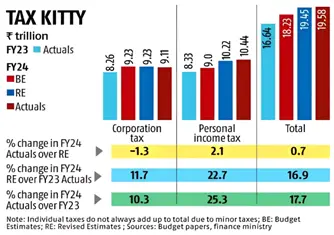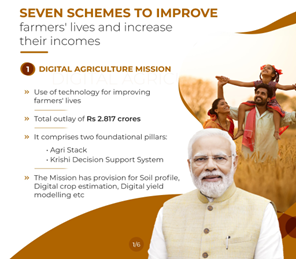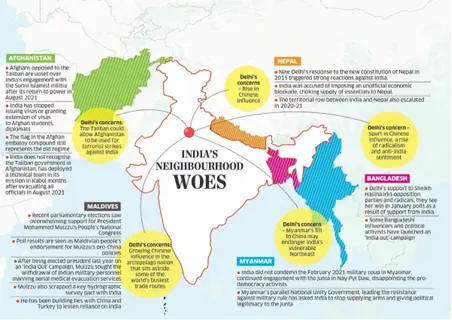Friday, 6th September 2024
Gap Between Allocations for Health
Why in the news?
- The effective utilisation of the Union Budget 2024-25 health allocations depends significantly on state-level factors, since states share the costs and oversee the implementation of Centrally Sponsored Schemes (CSS).
- Despite substantial budgetary provisions for health initiatives, such as the (PM-ABHIM) and (HRHME), these schemes are facing challenges with low utilisation rates.
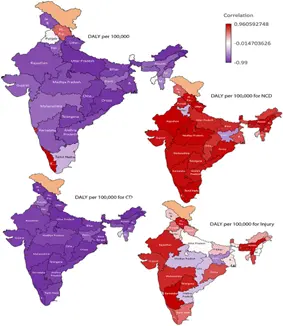
About the Centrally Sponsored Schemes:
- PM Ayushman Bharat Health Infrastructure Mission (PM-ABHIM)
- Objective: Enhance India’s health preparedness by establishing health and wellness centres (AB-HWCs), block-level public health units (BPHUs), integrated district public health laboratories (IDPHLs), and critical care hospital blocks (CCHBs).
- Purpose: Strengthen healthcare delivery systems and prepare for future emergencies like pandemics.
- Human Resources for Health and Medical Education (HRHME)
- Objective: Complement PM-ABHIM by expanding the number of medical professionals through new medical, nursing, and paramedical colleges and upgrading district hospitals linked to new medical colleges.
Issue of Low Fund Utilisation and Faculty Shortage:
- Poor Fund Absorption in PM-ABHIM:
- Status: Fund absorption has been suboptimal, with only 29% utilised in 2022-23.
- Reasons: Challenges include complex execution structures, reliance on health grants from the 15th Finance Commission (only 45% utilised), and delays in construction due to rigid procedures.
- Low Fund Utilisation in HRHME:
- Status: Utilisation of funds for educational infrastructure was only around 25% of the budget estimates in both 2022-23 and 2023-24.
- Shortage of Teaching Faculty:
- Status: Significant shortages are reported in newly established medical institutions, with over 40% faculty vacancies in 11 of the 18 All India Institutes of Medical Sciences (AIIMS).
- Example: In Uttar Pradesh, 30% of teaching faculty positions were vacant in 2022 for government medical colleges established between 2019 and 2021.
- Lack of Specialist Positions:
- Status:
- Shortages of specialists impact the establishment and upgrading of medical colleges and district hospitals.
- Over a third of sanctioned specialist positions in urban community health centres (CHCs) and two-thirds in rural CHCs remained vacant as of March 2022.
- Status:
Way Forward: Need for Strategic Planning and Long-term Sustainability
- Strategic Financial Planning: States need to forecast future financial requirements for health infrastructure and align these with available fiscal space.
- Prioritisation: Health should be prioritised within the broader development agenda, recognizing long-term social and economic benefits.
- Alternative Funding: Mobilising alternative sources of funding, such as public-private partnerships (PPPs) and health insurance schemes, is crucial for sustainability.
- Innovative Financing: Collaboration with private sector stakeholders and innovative financing models can help alleviate financial pressures and ensure the continuity of health services.
Government Initiatives Related to Healthcare in India:
- National Health Mission (NHM): Aims to enhance healthcare delivery systems across states, improving overall health infrastructure and services.
- Ayushman Bharat: Seeks to provide comprehensive health coverage to underserved populations, ensuring broader access to medical services.
- Pradhan Mantri Jan Arogya Yojana (AB-PMJAY): Provides health insurance for low-income families, covering a range of medical treatments and services.
- PM National Dialysis Programme: Expands dialysis facilities in government hospitals, increasing accessibility for patients with kidney conditions.
- Janani Shishu Suraksha Karyakram (JSSK): Offers free healthcare services for pregnant women and infants, including deliveries and essential postnatal care.
- Rashtriya Bal Swasthya Karyakram (RBSK): Focuses on child health screening and early intervention, aiming to detect and address health issues in children at an early stage.
Conclusion
The potential for India’s Union Budget allocations to transform the health sector is significant, but several challenges must be addressed to ensure these funds result in tangible improvements. Coordinated efforts between state and central governments are necessary to ensure that investments in health infrastructure are sustainable and effective.
Source: TH
Green hydrogen projects in India
Why in the news?
- The Ministry of New and Renewable Energy (MNRE) has exempted export-oriented green hydrogen projects from its list of domestic solar module manufacturers.
- This step aims to reduce the cost of green hydrogen production to levels comparable to grey hydrogen.
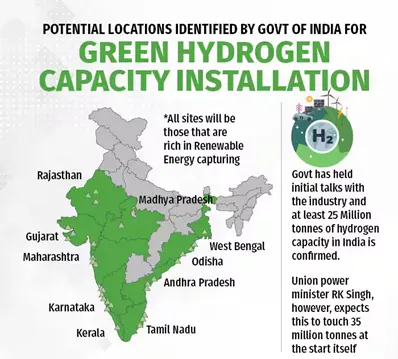
About Hydrogen:
- Properties: Hydrogen is the lightest chemical element. It is colourless, odourless, tasteless, non-toxic, and highly flammable.
- Abundance: It is the third most abundant element in the human body, following oxygen and carbon, and constitutes about 75% of the universe’s normal matter.
- Production: Hydrogen can be generated from various sources, including fossil fuels, nuclear energy, biomass, and renewable energy.
Types of Hydrogen:
- Grey Hydrogen:
- Produced via Steam Methane Reformation (SMR) from natural gas or methane, releasing CO2 directly into the atmosphere.
- Accounts for roughly 95% of global hydrogen production.
- Blue Hydrogen:
- Generated through SMR with carbon capture and storage (CSS), where CO2 is stored underground, limiting its release into the atmosphere.
- Considered "low carbon" as 10-20% of emissions may not be captured.
- Green Hydrogen:
- Produced using renewable energy to split water into hydrogen and oxygen via electrolysis, making it the cleanest form without CO2 emissions.
- Currently constitutes only 0.1% of global hydrogen production but is expected to grow as renewable energy costs decline.
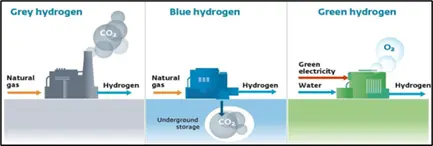
Green Hydrogen Revolution:
- Increasing Energy Demand:
- India ranks as the third-largest economy in the world concerning energy needs, and its energy demand is projected to surge.
- The demand is estimated to increase by 35% by 2030.
- Reducing Energy Import Cost:
- In 2022, India’s energy import bill stood at approximately $185 billion, and this figure is expected to rise if traditional energy sources continue to meet growing demands.
- The National Green Hydrogen Mission, led by MNRE, aims to cut fossil fuel imports worth Rs 1 lakh crore by 2030.
- Climate Goals and Emission Reduction:
- India pledged to achieve net-zero emissions by 2070 during the 2021 COP26 summit.
- Green hydrogen can help reduce at least 50 MMTPA of greenhouse gases by 2030.
- Enhancing Energy Security:
- Green hydrogen is essential for meeting India’s energy security needs and reducing emissions in hard-to-abate sectors on the path to net zero.
- India holds the potential to produce 210 Mtpa (598 Mtoe) of hydrogen from renewable sources, meeting 32% of the APAC region's hydrogen demand.
- Forex Earnings:
- Global hydrogen demand could reach 180 million tons by 2030, offering India the opportunity to transition from an energy importer to a global exporter.
- Geopolitical Implications:
- Growing Global Significance: Hydrogen's increasing importance in the energy space is influencing global technological and geopolitical trends.
- Renewable Energy Advantage: Countries with abundant renewable energy resources could emerge as major green hydrogen producers and exporters.
- Global Strategies: Countries like the EU, Japan, South Korea, and Singapore have formulated strategies to import green hydrogen, creating opportunities for Indian producers.
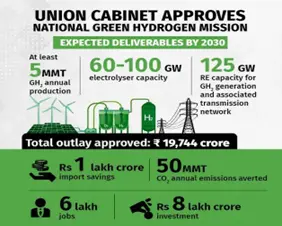
Green Hydrogen Challenges in India:
- Utilisation of Grey Hydrogen: Hydrogen production in India is currently reliant on natural gas within refineries and fertiliser industries.
- High Production Costs: Green hydrogen costs $4–5 per kilogram, roughly twice the price of grey hydrogen, driven by renewable electricity costs (50–70%) and electrolyzer costs (30–50%).
- Water-Intensive Nature of Electrolyzers: Electrolyzers consume about 9 liters of water per kilogram of hydrogen, highlighting the need for advancements in seawater electrolysis.
- Lack of Harmonised Standards: The absence of comprehensive standards for the manufacture and safety of green hydrogen across the production chain poses challenges.
- Inadequate Hydrogen Infrastructure: India's hydrogen infrastructure is underdeveloped, with only two refuelling stations in place.
Initiatives for Green Hydrogen Production in India:
- National Green Hydrogen Mission (Jan 2023):
- The mission aims to substitute grey hydrogen with green hydrogen in key industries such as fertilisers, petroleum refining, steel, and shipping.
- The goal is to produce at least 5 MMT of green hydrogen annually by 2030, with an additional renewable energy capacity of 125 GW.
- Green Hydrogen Policy (Feb 2022): Aimed at reducing landed costs of renewable power and facilitating the transition to green hydrogen.
- Strategic Interventions for Green Hydrogen Transition (SIGHT) Programme: Focused on providing financial incentives for domestic electrolyzer manufacturing and green hydrogen production.
- Exemption of Inter-State Transmission Charges: Green hydrogen and green ammonia projects commissioned before December 2030 are exempt from inter-state transmission charges for 25 years.
- Electricity (Promoting Renewable Energy through Green Energy Open Access) Rules (2022): These rules promote renewable energy supply for green hydrogen production.
- India Hydrogen Alliance: An industry coalition working towards creating a hydrogen value chain and promoting a Net-Zero pathway.
Green Hydrogen in India:
- Renewable Energy Capacity Addition:
- India’s renewable energy potential, particularly solar (estimated at 748 GW), can support green hydrogen growth, but rapid capacity expansion is required.
- The current installed solar capacity stands at 72.31 GW as of November 2023.
- Reducing Production Costs:
- Renewable Energy Tariffs: SECI has achieved a cost of INR 2.6/kWh through standalone solar and wind tenders, while RTC renewable energy tenders are priced at INR 4–4.5/kWh.
- Electrolyser Innovation:
- Increasing subsidies for early adopters and fostering indigenous electrolyzer technology is vital. For instance, the USA provides tax credits of up to $3/kg under the Inflation Reduction Act (IRA).
- Disincentivizing Carbon-Intensive Alternatives:
- Shifting subsidies from fossil fuels to green hydrogen projects can encourage infrastructure development.
- Europe has incorporated green hydrogen into its Emissions Trading System.
- Reducing Conversion, Storage, and Transport Costs:
- Energy Conversion: Encouraging companies to form clusters and bid for PLIs and other incentives.
- Transport: Investment in hydrogen transportation infrastructure, including pipelines, is needed. The EU's Hydrogen Backbone program serves as a model for pipeline development.
- Storage: Storage systems need intervention to reduce costs, which account for 30–40% of total renewable energy costs.
- MNRE’s Financial Allocations:
- ₹17,490 crore allocated under the SIGHT program for domestic electrolyser manufacturing and green hydrogen production.
- ₹400 crore set aside for Research and Development (R&D) projects.
About SIGHT Program
- Objective: The Strategic Interventions for Green Hydrogen Transition (SIGHT) program is designed to promote green hydrogen production and adoption in India.
- Key Features:
- Electrolyser Manufacturing: Focus on domestic manufacturing of electrolysers essential for green hydrogen production.
- Green Hydrogen Production: Encourages setting up green hydrogen facilities to position India as a global leader.
- Financial Allocation: ₹17,490 crore allocated for promoting investment in green hydrogen and electrolyser manufacturing.
- Employment and Investment: Aims to generate jobs and attract investments in clean energy technologies.
- Incentives: Includes waivers for transmission charges and R&D support to drive green hydrogen adoption.
Source: IE
Genome mapping of Chandipura virus
Why in the news ?
- Recently, The Gujarat Biotechnology Research Centre (GBRC) in Gandhinagar has successfully published the first fully mapped genome of the Chandipura Vesiculovirus (CHPV).
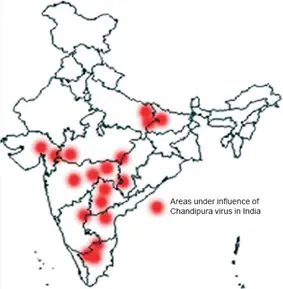
Genome Mapping:
- Definition: Genome mapping is the process of identifying the locations of genes and key sequences on a genome.
- Significance: Provides critical information on the origin, evolution, and mutations of a virus that could affect its transmissibility and lethality.
- Types:
- Genetic Maps: Show the relative positions of genes based on recombination frequency.
- Physical Maps: Indicate the absolute positions of genes based on DNA base pairs.
- Applications:
- Genetic Disorders: Aids in diagnosing and treating genetic diseases.
- Personalised Medicine: Enables custom treatment plans based on individual genetic profiles.
- Agriculture: Identifies desirable traits in crops and livestock for breeding.
- Vaccine and Drug Development: Helps in the development of vaccines and drugs by understanding the genomic structure of pathogens.
- Evolutionary Studies: Provides insights into the evolutionary relationships between species.
- Challenges:
- Complexity: Larger genomes are difficult to map due to repetitive sequences.
- Ethical Concerns: Raises questions regarding privacy and use of genetic data.
- Cost and Resources: Genome mapping remains resource-intensive.
- Data Interpretation: Interpreting mapped genes is complex due to gaps in knowledge.
Chandipura Vesiculovirus (CHPV):
- About: A viral infection causing Acute Encephalitis Syndrome (AES), marked by fever, headache, convulsions, and often leading to death within days.
- Family and Vectors: Belongs to the Rhabdoviridae family; transmitted by Phlebotomine sandflies, Phlebotomus papatasi, and Aedes aegypti mosquitoes.
- Transmission: Once transmitted, the virus attacks the central nervous system, leading to encephalitis, altered mental status, seizures, and respiratory distress.
- Affected Population: Primarily affects children under 15 years, with outbreaks being seasonal, often during monsoons.
- Historical Outbreaks: First identified in 1965 in Maharashtra, with significant outbreaks in 2003-04 in Maharashtra, Gujarat, and Andhra Pradesh, leading to over 300 deaths.
- Endemic Regions: Predominantly reported in central India, particularly rural, tribal, and peripheral areas.
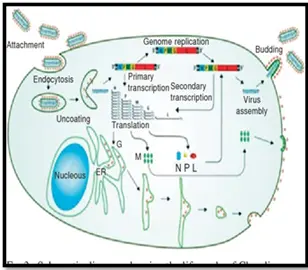
Key Findings from GBRC's Genome Mapping of CHPV:
- No Major Genetic Change: The recent Gujarat outbreak strain closely resembles the 2012 strain, with only one amino acid mutation in the glycoprotein-B gene, crucial for binding to human cells.
- Low Viral Load but Severe Symptoms: Despite a low viral load indicated by high Ct values in RT-PCR tests, the virus still led to severe symptoms.
- Indigenous Virus: Genome sequencing confirmed the virus is not imported, being indigenous to India and closely related to strains from past outbreaks in 2003-04 and 2007.
Source: IE
Households building back financial savings in India
Why in the news?
- Recently, the Deputy Governor of the Reserve Bank of India (RBI), during the Financing 3.0 Summit of the Confederation of Indian Industry (CII), emphasised that Indian households are rebuilding their financial savings post-pandemic.
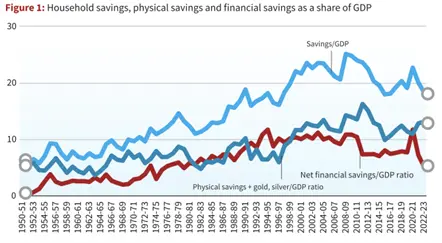
Current Trend in Household Savings
- Recovery of Household Savings: Household financial savings nearly halved from 2020-21 levels due to reduced pandemic-era savings and a shift towards physical assets like housing.
- Financial Assets: Household financial assets have grown from 10.6% of GDP (2011-17) to 11.5% (2017-23, excluding the pandemic year).
- Physical Assets: Physical savings have surpassed 12% of GDP post-pandemic, though still lower than the 16% recorded in 2010-11.
- Future Prospects: With rising incomes, financial savings are expected to recover to early 2000s levels, potentially reaching 15% of GDP.
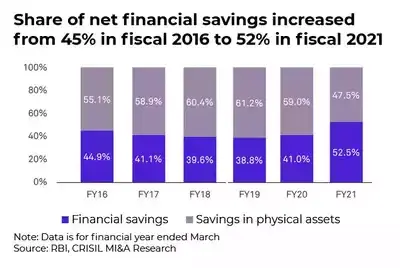
Impact of Household Savings on the Economy
- Interest Rates: Variations in household savings influence monetary policy. Lower savings may lead to higher interest rates to incentivize savings.
- Enhanced Lending Capacity: As households rebuild financial strength, they are likely to become key net lenders in the economy, especially as corporate borrowing needs increase.
- Corporate Borrowing: Though corporate borrowing has decreased, rising capital expenditure (capex) is expected to heighten future borrowing demands, with households filling this financing gap.
- Economic Stability: Higher physical savings contribute to long-term economic stability by diversifying investments, though liquidity might be limited.
- Implications for External Financing: Rising domestic savings may reduce the need for external financing, but external debt sustainability will remain critical.
Household Savings: Definition and Components:
- About: Household (HH) savings in India consist of two main components: net financial savings (NFS) and physical savings.
- Net Financial Savings (NFS): Calculated by subtracting financial liabilities from gross financial savings (GFS). GFS includes currencies, deposits, insurance, provident and pension funds, shares and debentures, small savings, and others.
- Physical Savings: Primarily consist of residential real estate (about two-thirds) and machinery/equipment owned by producers in the household sector.
- Household Savings to GDP Ratio: Includes the sum of net financial savings, physical savings, and investments in gold and ornaments as a percentage of GDP.
Trends in Household Savings:
- Shift to Riskier Assets: There is an increasing trend toward investing in riskier financial assets like stocks and debentures.
- Pandemic Impact: During the COVID-19 pandemic, households saved more due to limited spending options, resulting in high financial savings and shifts toward physical assets such as real estate and gold.
- Decline in Financial Savings: Net financial savings of households dropped from Rs 23.3 lakh crore in 2020-21 to Rs 14.2 lakh crore in 2022-23, while physical savings surged.
- Household Debt: Rising spending on real estate and lifestyle expenses, coupled with increasing healthcare and education costs, has led to a decline in savings and higher household debt.
Government Initiatives Related to Household Savings:
- Sukanya Samriddhi Account Scheme: A savings scheme aimed at the education and marriage expenses of the girl child, offering attractive interest rates and tax benefits under Section 80C of the Income Tax Act.
- Senior Citizens’ Savings Scheme (SCSS): Designed for senior citizens above the age of 60, this scheme provides a higher interest rate and is available with a maturity period of 5 years. It is eligible for tax benefits under Section 80C.
- Kisan Vikas Patra (KVP): A savings certificate scheme that doubles the invested amount over a predetermined period. It is available at post offices and is considered a risk-free investment option for individuals.
- Mahila Samman Savings Certificate: A new small savings scheme for women with a fixed interest rate for two years. It offers partial withdrawal options, making it a flexible investment for women.
- Employees' Provident Fund (EPF): A government-mandated savings scheme for salaried employees, where both employer and employee contribute a portion of the salary. It offers retirement security and tax benefits under Section 80C.
- National Pension System (NPS): A voluntary retirement savings scheme that allows individuals to accumulate savings during their working life. It offers a mix of equity and debt investments with tax benefits under Section 80CCD(1B).
- Public Provident Fund (PPF): A long-term savings scheme with a tenure of 15 years, offering tax-free returns and guaranteed interest. It is one of the safest investment options with benefits under Section 80C.
- National Savings Certificate (NSC): A fixed-income investment scheme, primarily used for small to medium savings, with benefits under Section 80C. It comes with a fixed maturity period and interest rate.
- Post Office Monthly Income Scheme (POMIS): A government-backed savings scheme that offers regular monthly income to investors. It has a 5-year lock-in period, and premature withdrawal is allowed after one year with a penalty. The income is not subject to TDS.
|
UPSC Civil Services Examination, Previous Year Question Prelims Q:1 As per the NSSO 70th Round “Situation Assessment Survey of Agricultural Households”, consider the following statements: (2018)
Which of the statements given above is/are correct?
Ans: c |
Source: IE
Kerala access funds from the Loss and Damage Fund
Why in the news?
- Recently hit Kerala's Wayanad district, an important discussion has arisen on the possibility of subnational entities seeking compensation via the UNFCCC's Loss and Damage Fund (LDF).
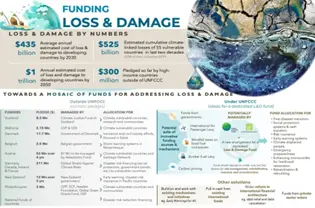
What is the Loss and Damage Fund?
- Establishment:
- It was established at the 2022 United Nations Framework Convention on Climate Change (UNFCCC) Conference (COP27) in Egypt.
- Objective:
- The 'Loss and Damage' (L&D) fund is a financial mechanism established to address the irreversible impacts of climate change that cannot be mitigated through adaptation efforts.
- Adaptation involves proactive measures to prepare for and cope with climate-related challenges.
- The fund aims to compensate for the tangible and intangible losses incurred by communities, countries, and ecosystems due to climate change, touching on human rights, well-being, and environmental sustainability.
Genesis and Evolution of the L&D Fund:
- Historical Accountability and Inception:
- For over 30 years, there has been a call for wealthy nations to acknowledge their historical contributions to climate change, which has increased global temperatures by over 1°C and caused significant damage, particularly in poorer nations.
- COP 19 (2013):
- The 19th Conference of the Parties (COP 19) to the United Nations Framework Convention on Climate Change (UNFCCC), held in Warsaw, Poland, led to the establishment of the L&D fund to support economically developing nations affected by climate change.
- Subsequent Developments and Challenges:
- COP 25: The Santiago Network for L&D was established, but no funds were committed by countries at this stage.
- COP 26: The Glasgow summit aimed to continue discussions on the fund’s operationalization over the next three years.
- COP 27 (November 2022): After extensive negotiations, an agreement was reached to set up the L&D fund, and a Transitional Committee (TC) was formed to develop operational recommendations for consideration at COP 28.
- Stalemate at TC4 and TC5:
- TC4 Meeting:
- The fourth TC meeting ended without consensus on fund operationalization.
- Disagreements included the fund's hosting at the World Bank, common but differentiated responsibilities (CBDR), climate reparations, and eligibility criteria.
- TC5 Meeting:
- Recommendations from TC5 have been drafted and submitted to COP 28.
- TC4 Meeting:
India Take Advantage of the Loss and Damage Fund (LDF):
- India has incurred over $56 billion in damages from weather-related disasters between 2019 and 2023.
- Despite this, India's National Climate Action Policy and budget prioritise mitigation over adaptation, leading to limited participation in Loss and Damage (L&D) dialogues at COP meetings.
- To better address its vulnerabilities, India should advocate for more decentralised allocation of LDF funds in international climate negotiations.
Need for More Decentralised Funding from the LDF:
- Local Management: Decentralised funding allows state governments to directly manage and utilise resources based on regional needs, improving adaptation and recovery efforts.
- Enhanced Adaptation: States like Kerala, which experienced significant flooding in 2018, can benefit from targeted funding to support localised recovery programs.
- Negotiation Leverage: By promoting decentralised fund allocation, India can better align international support with domestic priorities, strengthening its position in climate negotiations.
- Efficient Utilisation: Direct access to funds ensures that resources are allocated swiftly and effectively to areas most impacted by climate-related disasters.
- Strengthened Resilience: Localised funding supports targeted investments in building resilience against climate impacts, addressing specific vulnerabilities more effectively.
Challenges Regarding the Loss and Damage Fund:
- Developed Nations' Reluctance:
- Wealthy nations, especially the US, have been hesitant to commit as primary donors.
- Their voluntary support raises concerns about the fund’s sustainability and effectiveness, undermining faith in global climate negotiations.
- Uncertainty Surrounding the Fund:
- There is currently no clear indication of the fund's size or detailed framework, with pressures from the U.K. and Australia leading to a vague draft that only invites voluntary contributions from developed nations.
- Diplomatic Breakdown and Global Consequences:
- Developing nations feel their concerns are not adequately addressed, complicating climate action efforts and global cooperation.
- This situation exacerbates the suffering of vulnerable communities in developing nations, potentially leading to climate justice issues.
- Security Implications of Climate-Change-Induced Instability:
- Climate-induced instability can lead to conflicts and tensions in vulnerable nations, posing security challenges that may extend across borders.
- The lack of support for these communities can worsen humanitarian crises, including food shortages and displacement, forcing them to handle escalating climate impacts independently.
Way Forward:
- Global Commitment: Urge developed nations to actively contribute as primary donors to the L&D fund to ensure robust financial support.
- Transparency and Structure: Advocate for clear discussions to establish the fund's size, operational guidelines, and allocation mechanisms to ensure transparency and accountability.
- Inclusive Diplomacy: Promote open dialogues to address the concerns of developing nations, fostering collaboration for effective climate action and global issue resolution.
- Security Mitigation: Address the security implications of climate-induced instability through proactive measures to tackle humanitarian crises and support vulnerable communitie
|
UPSC Civil Services Examination, Previous Year Questions (PYQs) Mains Q:1 Explain the purpose of the Green Grid Initiative launched at the World Leaders Summit of the COP26 UN Climate Change Conference in Glasgow in November 2021. When was this idea first floated in the International Solar Alliance (ISA)? (2021) Q:2 Describe the major outcomes of the 26th session of the Conference of the Parties (COP) to the United Nations Framework Convention on Climate Change (UNFCCC). What are the commitments made by India in this conference? (2021) |
Source: TH
Exercise Varuna
Why in the news?
- Recently, a P8I aircraft of the Indian Navy has reached France to participate in ‘Exercise Varuna’ with the French Navy.

About the Exercise Varuna:
- Background:
- Initiation: The exercise began in 1993 and was officially named ‘VARUNA’ in 2001.
- Significance: Exercise Varuna is a key element of the India-France strategic bilateral relationship.
- 2024 Edition:
- Location: Scheduled to take place in the Mediterranean Sea.
- Activities: Includes advanced tactical exercises designed to enhance synergy and interoperability between the Indian and French navies.
- Indian Navy's Participation:
- Aircraft: A P-8I aircraft from the Indian Navy, known for its maritime surveillance and anti-submarine warfare capabilities, is participating in the exercise.
- Other Assets: The P-8I will join the INS Tabar in the exercises.
- Significance of P-8I Aircraft:
- Description: The P-8I is a long-range, multi-mission maritime patrol aircraft manufactured by Boeing.
- Role: It has replaced the Indian Navy’s older Tupolev Tu-142 aircraft, enhancing the Navy’s maritime surveillance and anti-submarine warfare capabilities.
Source: TH
Vishvasya-Blockchain Technology Stack
Why in the news?
- The Ministry of Electronics and Information Technology (MeitY) recently launched a series of blockchain-based solutions including the Vishvasya-Blockchain Technology Stack.

Vishvasya-Blockchain Technology Stack:
- About:
- The Ministry of Electronics and Information Technology (MeitY) has introduced the Vishvasya-Blockchain Technology Stack as part of its blockchain-based solutions initiative.
- Key Features:
- Blockchain-as-a-Service (BaaS): The Vishvasya stack provides a BaaS platform supporting various permissioned blockchain applications.
- Geographical Distribution: Hosted across NIC Data Centers in Bhubaneswar, Pune, and Hyderabad to ensure robust and scalable service delivery.
- Additional Introductions:
- NBFLite: A lightweight blockchain platform.
- Praamaanik: A blockchain-enabled solution for verifying the authenticity of mobile apps.
- Applications of Vishvasya BaaS:
- e-Stamps Solution: For digital stamp management.
- Judiciary Application: Enhancing judicial processes.
- IPS Officers' Training Record Management: Maintaining training records.
- Forensic Application: For forensic record management.
- Praamaanik: Mobile app authenticity verification.
- Consent Management Framework: Managing consent records.
- IoT Device Security Management: Ensuring IoT device security.
- Cotton Bale Identification and Tracking: Tracking cotton bales.
- Domicile Certificate Chain: Managing domicile certificates.
- Document Chain: Includes Caste Certificate Chain and other document management systems.
National Blockchain Framework (NBF):
- Objective:
- The National Blockchain Framework aims to create reliable and secure digital platforms.
- Key Components:
- Distributed Infrastructure: Supports decentralised operations.
- Core Framework Functionality: Provides essential blockchain features.
- Smart Contracts & API Gateway: Facilitates smart contract execution and integration.
- Security, Privacy & Interoperability: Ensures secure, private, and interoperable blockchain transactions.
- Platform Support:
- The NBF currently supports two permissioned blockchain platforms and is designed for future extensibility.
Source: ET
Food Recovery to Avoid Methane
Why in the news ?
- The Food Recovery to Avoid Methane Emissions (FRAME) methodology estimates that each food bank cuts GHG emissions equivalent to removing 900 gasoline cars from the road for a year.

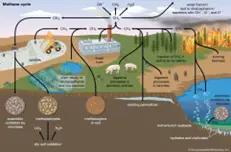
Food Recovery to Avoid Methane Emissions (FRAME) Methodology
- About:
- The FRAME methodology quantifies the environmental benefits of redirecting food loss and waste to human consumption, highlighting its role in reducing greenhouse gas (GHG) emissions.
- Key Features:
- Purpose: Measures avoided emissions and co-benefits from food recovery and redistribution operations.
- Impact: Each food bank's efforts can offset GHG emissions equivalent to removing 900 gasoline-powered cars from the road for a year.
- Development:
- Creators: Developed by the Global Food Banking Network (GFN) in collaboration with the Global Methane Hub and the Carbon Trust.
- Pilot Phase: Initially piloted in Mexico and Ecuador, analysing six community-led food banks.
- Applications:
- Users: Designed for food banks, food recovery organisations, private sector companies, and experts in the food loss and waste sector.
- Functionality: Provides tools to accurately measure and manage emissions related to food recovery and redistribution.
- Global Methane Hub
- Mission:
- The Global Methane Hub focuses on reducing global methane emissions and increasing philanthropic funding for methane reduction efforts.
- Key Contributions:
- Funding: Donated $10 million to the Climate and Clean Air Coalition (CCAC) to support 30 countries in developing plans to cut methane emissions.
- Mission:
Source: DTE
Smart Cities Mission 90% Completed
Why in the news ?
- The Smart Cities Mission (SCM), aimed at improving urban living standards, has recently achieved over 90% completion of its total projects, as reported by the Ministry of Housing and Urban Affairs.
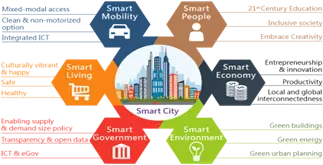
About the Smart Cities Mission (SCM):
- Launch Date: June 25, 2015.
- Objective: To develop cities with essential infrastructure, a clean and sustainable environment, and a high quality of life through 'smart solutions.'
- Aim: To foster economic growth and enhance quality of life by addressing the social, economic, physical, and institutional aspects of urban areas.
- Focus: Sustainable and inclusive development through models that can serve as examples for other cities.
- City Selection: 100 cities were chosen for development between 2016 and 2018 through a two-stage competition, with a five-year period allocated for project completion.
- Scheme Type: It is a Centrally Sponsored Scheme administered by the Union Ministry of Housing and Urban Affairs (MoHUA).
- Core Infrastructure Elements: Include reliable water supply, consistent electricity, sanitation and waste management, efficient transportation, affordable housing, strong IT connectivity, e-Governance, citizen safety, and health and education services.
- Strategic Components: Involve city improvement (retrofitting), city renewal (redevelopment), city extension (Greenfield development), and Pan-city initiatives applying smart solutions across larger areas.
Funding:
- Central Government: Will provide ₹48,000 crores over five years, averaging ₹100 crore per city annually.
- State/Urban Local Bodies (ULBs): Required to match the central funding amount.
- Additional Resources: To be sourced from ULB funds, Finance Commission grants, Municipal Bonds, other government programs, and borrowings.
- Private Sector Participation: Encouraged through Public-Private Partnerships (PPP).
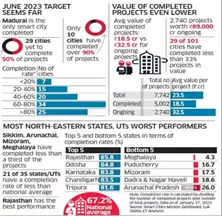
|
UPSC Civil Services Examination, Previous Year Question (PYQ) Mains: Q:1 With a brief background of quality of urban life in India, introduce the objectives and strategy of the ‘Smart City Programme.’ (2016) |
Source: TH
Transforming Agriculture into India's Growth Engine
Context:
- Agriculture currently employs 46% of the workforce and contributes 18% to GDP.To transform agriculture into a key driver of economic growth, it is crucial to address ecological, technological, and institutional barriers.
- This involves replenishing water resources, increasing irrigation coverage, diversifying crops, and adopting advanced techniques like micro-irrigation and climate-resilient farming.
- Indian agriculture can become more technologically advanced, sustainable, and economically viable, attracting educated youth and contributing to national growth.
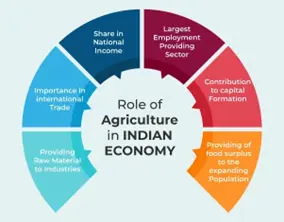
Current Status of the Indian Agriculture Sector:
- Economic Contribution: Agriculture and allied sectors contributed 18.8% to India's Gross Value Added (GVA) in 2021-22. The sector demonstrated resilience during the pandemic, growing by 3.9% in 2021-22, compared to 3.6% in 2020-21.
- Employment: Agriculture employs around 42% of India's workforce, but its share has been steadily declining from 81% in 1983.
- Production: India's foodgrains production reached a record 315.7 million tonnes in 2021-22 despite climate change challenges. (Economic Survey 2022-23)
- Exports: Agricultural exports saw a 19.92% growth in 2021-22, totaling USD 50.21 billion. Key exports include rice, wheat, cotton, and spices.
- Organic Farming: The total area under organic certification (registered under the National Programme for Organic Production) is 7.3 million hectares as of 2023-24.
Recent Technological Developments in Indian Agriculture:
- Drone Technology: In 2021, the government approved subsidies of up to 100% for the purchase of agriculture drones by farm machinery training institutes. The Namo Drone Didi scheme aims to provide drones to 15,000 selected women Self-Help Groups (SHGs) between 2023-24 and 2025-26.
- Satellite Imaging and Remote Sensing: ISRO's RISAT-1A satellite, launched in 2022, supports agricultural assessment and improvement through advanced satellite imaging and remote sensing.
- Happy Seeder Technology: This technology, designed to address stubble burning, allows wheat sowing without removing paddy straw, thus reducing air pollution and enhancing soil health.
- PUSA Decomposer: Developed by the Indian Agricultural Research Institute (IARI), this microbial solution decomposes crop residues quickly when sprayed on stubble.
- Nano Urea: Introduced by IFFCO in 2021, Nano Urea is a liquid fertiliser containing nanoscale nitrogen particles that improve nutrient use efficiency while reducing environmental pollution.
Indian Agriculture Underperforming Despite Employing the Majority:
- Fragmented Land Holdings: India’s agricultural land is highly fragmented, with 86.1% of farmers owning less than 2 hectares. This fragmentation limits mechanisation, credit access, and the adoption of modern techniques, reducing productivity.
- Changing Climate: India relies heavily on monsoons, with only 52% of cultivated land irrigated. Climate change further reduces agricultural incomes by 15-18%, exemplified by the recent heat waves that damaged crops.
- Market Inefficiencies: The APMC system often exploits farmers, with them receiving only 15-20% of retail prices. Although e-NAM aims to unify markets, it still faces adoption challenges.
- Credit Crunch: Limited formal credit access forces farmers to rely on high-interest informal loans, leading to debt traps. Over 50% of agricultural households are in debt, increasing poverty and suicides.
- Policy Paralysis: Subsidies distort market dynamics, while the MSP system leads to overproduction of certain crops, affecting sustainability and incomes.
- Post-Harvest Losses: India suffers from inadequate storage and transportation, losing ₹92,651 crore annually in post-harvest losses. Cold storage can only hold 11% of the total produce.
- Gender Disparity: Women make up 42% of the agricultural workforce but own only 14% of land. This limits their access to credit and resources, although initiatives like Mahila Kisan Sashaktikaran Pariyojana aim to address this imbalance.
Productivity Challenges:
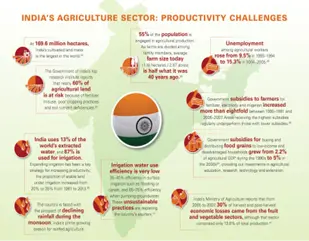
Recent Government Initiatives in Indian Agriculture :
- Pradhan Mantri Kisan Samman Nidhi (PM-KISAN): Provides ₹6,000 annually to small and marginal farmers. As of March 2023, over ₹2.5 lakh crore has been disbursed to more than 12 crore farmers.
- Pradhan Mantri Fasal Bima Yojana (PMFBY): Covers over 5 crore farmers and provides insurance against crop losses due to natural calamities. The scheme has seen a premium collection of approximately ₹22,000 crore with claims exceeding ₹25,000 crore.
- Soil Health Card Scheme: Issued around 31 crore soil health cards since its launch in 2015, offering farmers specific advice on soil health and nutrient management.
- Pradhan Mantri Krishi Sinchai Yojana (PMKSY): Aims to improve irrigation infrastructure with a target of achieving 'Har Khet Ko Pani' (water to every field). As of 2022-23, over 68 lakh hectares of land have been covered under irrigation schemes.
- e-National Agriculture Market (e-NAM): Launched in 2016, it connects over 1,000 mandis across 18 states. By February 2024, approximately 1.77 crore farmers and 1.29 lakh traders were registered on the platform.
- National Mission on Sustainable Agriculture: Promotes sustainable practices and aims to improve soil health, enhance water use efficiency, and increase crop productivity. The mission supports various initiatives including organic farming and climate-resilient crops.
- Paramparagat Krishi Vikas Yojana (PKVY): Supports organic farming through subsidies for organic inputs and certification. The scheme covers over 2 lakh hectares of land as of 2022.
- Digital Agriculture Mission: Aims to promote digital solutions in agriculture, including precision farming and data-driven decision-making. The mission focuses on integrating technologies like drones, AI, and IoT into farming practices.
Measures to Enhance Agricultural Productivity:
- Precision Agriculture: Utilise GPS, IoT sensors, and data analytics to optimise resource use. Pilot projects, like those in Maharashtra, have shown increased yields and reduced water use. Nationwide adoption could save billions of litres of water and boost productivity.
- Crop Diversification: Encourage farmers to grow a variety of crops to boost income and soil health. Initiatives like the push for millets and successful programs in Odisha highlight the benefits of diversification in improving farmer incomes and nutritional security.
- Farmer Producer Organizations (FPOs): Strengthen FPOs to achieve economies of scale. Models like Sahyadri Farmers Producer Company, which increased incomes by 25-30%, can be replicated across India to enhance productivity and farmer earnings.
- Climate-Smart Agriculture: Adopt practices like drought-resistant crops and water conservation. New varieties like Swarna-Sub1 and the release of 109 crop varieties by the Prime Minister demonstrate progress in improving yield and resilience.
- Agri-Tech Startups: Support agri-tech startups that drive innovation, such as DeHaat. Creating an ecosystem with incubation centres and funding can accelerate technology adoption in agriculture.
Conclusion
Transforming Indian agriculture requires precision farming, crop diversification, and post-harvest infrastructure improvements. Strengthening FPOs and leveraging agri-tech advancements will enhance productivity and sustainability, driving economic growth in the sector.
|
UPSC Civil Services Examination, Previous Year Question (PYQ) Prelims: Q:1 In the context of India’s preparation for Climate -Smart Agriculture, consider the following statements: (2021)
Which of the statements given above are correct?
Ans: (d)
Q:2 Consider the following pairs: (2014) Programme/Project Ministry
Which of the above pairs is/are correctly matched?
Ans: (d)
Q:3 In India, which of the following can be considered as public investment in agriculture? (2020)
Select the correct answer using the code given below:
Ans: (c)
Mains: Q;1 Given the vulnerability of Indian agriculture to vagaries of nature, discuss the need for crop insurance and bring out the salient features of the Pradhan Mantri Fasal Bima Yojana (PMFBY). (2016) Q:2 Explain various types of revolutions, took place in Agriculture after Independence in India. How have these revolutions helped in poverty alleviation and food security in India? (2017) |
Source: IE
Share the article
Edukemy’s Current Affairs Quiz is published with multiple choice questions for UPSC exams
MCQ
Get Latest Updates on Offers, Event dates, and free Mentorship sessions.

Get in touch with our Expert Academic Counsellors 👋
FAQs
UPSC Daily Current Affairs focuses on learning current events on a daily basis. An aspirant needs to study regular and updated information about current events, news, and relevant topics that are important for UPSC aspirants. It covers national and international affairs, government policies, socio-economic issues, science and technology advancements, and more.
UPSC Daily Current Affairs provides aspirants with a concise and comprehensive overview of the latest happenings and developments across various fields. It helps aspirants stay updated with current affairs and provides them with valuable insights and analysis, which are essential for answering questions in the UPSC examinations. It enhances their knowledge, analytical skills, and ability to connect current affairs with the UPSC syllabus.
UPSC Daily Current Affairs covers a wide range of topics, including politics, economics, science and technology, environment, social issues, governance, international relations, and more. It offers news summaries, in-depth analyses, editorials, opinion pieces, and relevant study materials. It also provides practice questions and quizzes to help aspirants test their understanding of current affairs.
Edukemy's UPSC Daily Current Affairs can be accessed through:
- UPSC Daily Current Affairs can be accessed through Current Affairs tab at the top of the Main Page of Edukemy.
- Edukemy Mobile app: The Daily Current Affairs can also be access through Edukemy Mobile App.
- Social media: Follow Edukemy’s official social media accounts or pages that provide UPSC Daily Current Affairs updates, including Facebook, Twitter, or Telegram channels.

